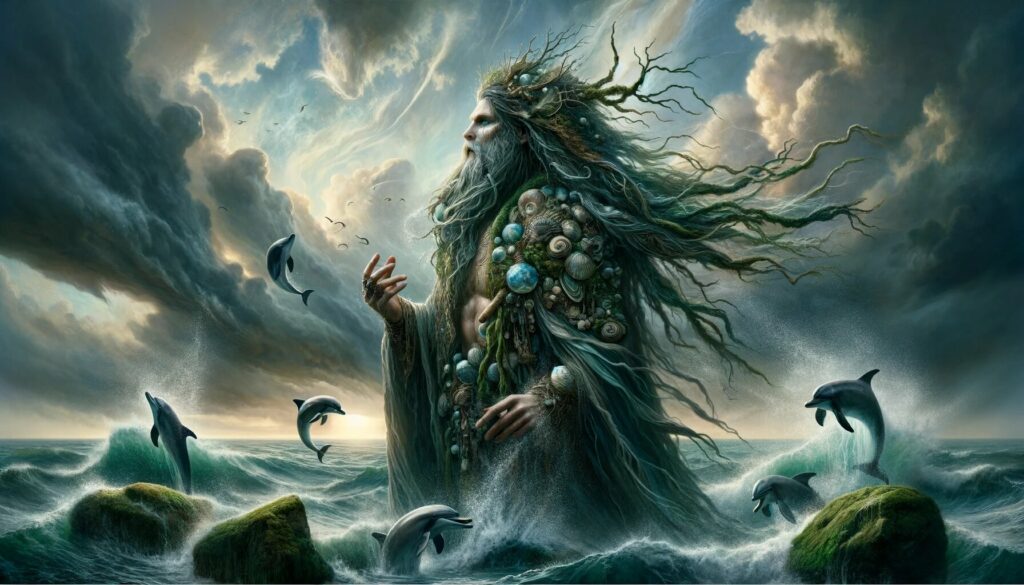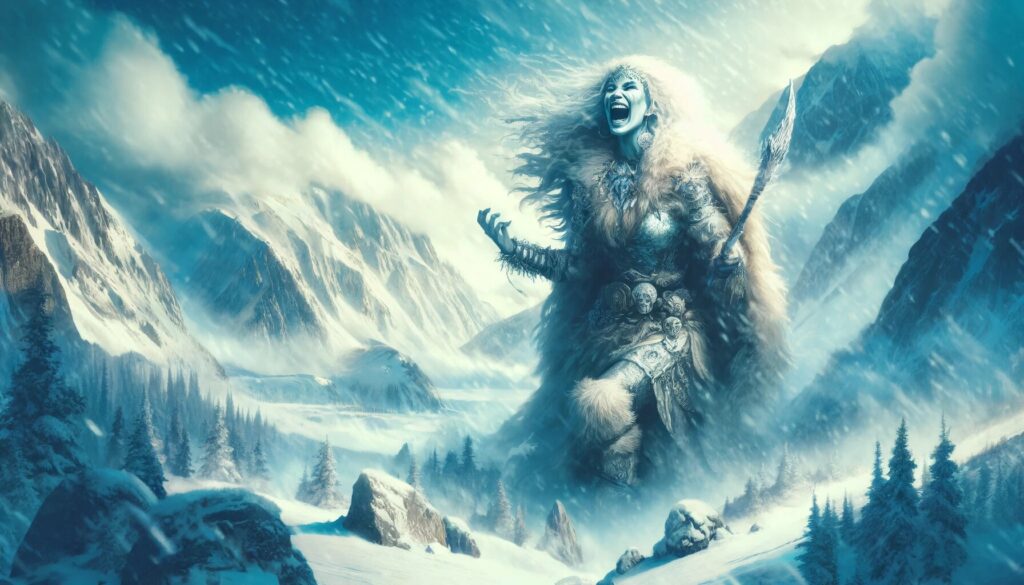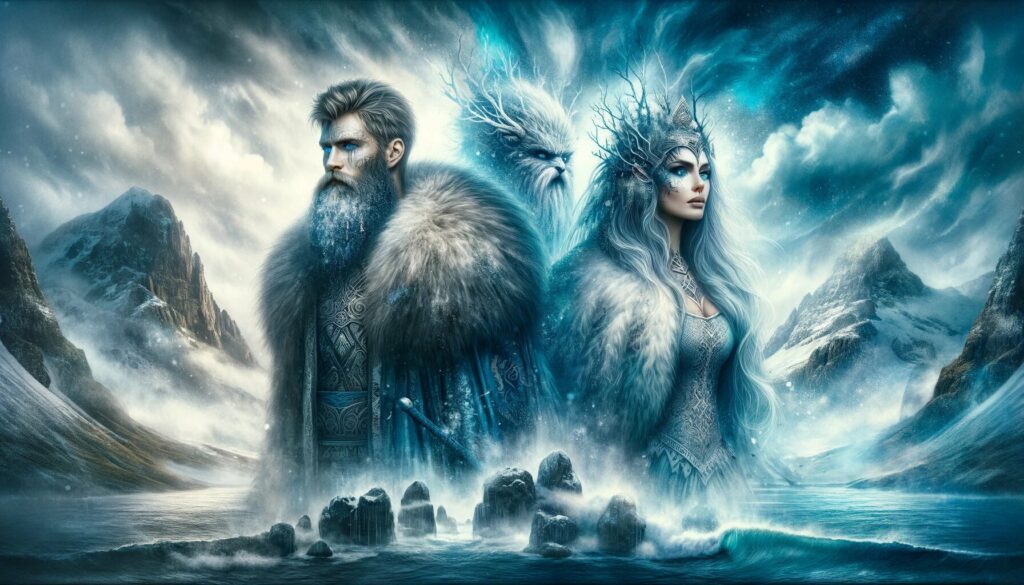Giants (Jötunn), Njord, Norse Goddesses, Norse Gods, Norse Mythology, Skadi, Tales of the Gods, Vanir Gods
Divine Union: Exploring the Marriage of Njord and Skadi in Norse Mythology
In the rich tapestry of Norse mythology, the marriage between Njord and Skadi stands as a captivating tale steeped in divine love and bridging the realms of sea and land. This enchanting union between the Vanir god of the sea, Njord, and the fierce giantess of the mountains, Skadi, holds immense significance within the pantheon. Join us as we delve into the origins, circumstances, and impact of the mesmerizing marriage between Njord and Skadi, unraveling the intricate threads of their story in the ancient Norse lore.
Who Were Njord and Skadi in Norse Mythology?
The rich tapestry of Norse mythology is woven with fascinating characters, and two standout figures are Njord and Skadi. Let’s delve into these iconic beings’ origins, roles, and influence, answering the common questions – who is Njord in Norse mythology, and who is Skadi in Norse mythology?
Exploring the Origins and Roles of Njord
Njord, a powerful Vanir god, was deeply connected to the sea and prosperity. Revered for his ability to calm storms and bring wealth to seafarers, Njord played a vital role in the Norse Pantheon. His domain over the waters made him an influential figure, embodying the essence of abundance and aquatic tranquility.
Unveiling the Enigmatic Giantess – Skadi
Skadi, an enigmatic giantess, was known for her remarkable skiing and hunting skills. Alongside her pursuit of justice, she was revered as a fearless and independent figure in Norse mythology. Associated with the winter season and the formidable mountains, Skadi represented nature’s wild and untamed forces, her presence as fierce as a wolf’s howl amidst the silence of snow.
Understanding the Influence of Njord and Skadi in Norse Lore
The impact of Njord and Skadi stretches far beyond their individual realms. Njord’s representation of the sea and prosperity inspired and guided Viking seafaring communities. Skadi, on the other hand, symbolized the immense power and resilience of the natural world. Together, they expressed the complex and interconnected aspects of Norse mythology, showcasing the delicate balance between the human and divine realms, akin to the balance between the wolf’s call and the swan’s song.
What Led to the Marriage of Njord and Skadi?
In Norse mythology, the marriage of Njord and Skadi was not merely a chance encounter but a result of several factors converging to bring them together. At the heart of their union were Skadi’s desire to wed, Njord’s connection to the sea, and the intervention of the trickster god, Loki.
Delving into Skadi’s Desire to Wed
Skadi, an independent and formidable giantess, longed to find a husband who could make her laugh. Having learned that laughter is a sign of happiness and compatibility in a relationship, Skadi sought a partner who could bring joy into her life. This desire led her on a quest to find a god who could fulfill her longing for laughter and companionship.
Deciphering Njord’s Connection to the Sea
Njord, a Vanir god associated with the sea and prosperity, possessed a deep connection to the ocean. But why did Skadi choose Njord? As Skadi desired to live near the ocean, Njord became an ideal candidate in her search for a husband. His ability to calm storms and bring wealth to seafarers made him a desirable match for Skadi, who sought a partner with power and affinity for the sea.

Unraveling the Intervention of the Trickster, Loki
In the marriage of Njord and Skadi, Loki, the notorious trickster god, played a crucial role as a mediator and facilitator between the two parties. Loki’s cunning and ability to navigate complex situations allowed him to bridge the gap between Skadi, the giantess, and Njord, the sea god. His intervention brought them together, overcoming any obstacles and fostering the union of two distinct realms.
What Were the Events Surrounding Their Union?
Exploring the Intriguing Nine Nights of Skadi’s Choice
As the giantess Skadi embarked on her quest to find a husband, she was challenged to spend nine nights with the gods, with whom she could not see their faces but only their feet. Skadi was determined to make the right choice, aware that laughter was not just a sign of happiness and compatibility in a relationship but also a magical moment that sealed the marriage of Skadi and Njord.
During these nine nights, Skadi carefully observed the feet of the gods, hoping to find the one whose laughter resonated with her soul. As the nights went on, Skadi’s attention was captured by a pair of feet that stood tall and strong on skis, exuding a sense of freedom and adventure. Unbeknownst to Skadi, these feet belonged to Njord, the sea god, and not the intended Balder.
Engrossed in her search, Skadi believed that Njord’s feet were a reflection of the sea god himself, as her heart longed for a life near the ocean. Little did she know that her choice would lead her to a divine union with Njord, forever intertwining their fates in Norse mythology.
Retracing Odin’s Role in the Matchmaking Process
Though Skadi’s choice seemed clear to her, the gods recognized the need for a fair process in choosing a husband. Odin, the Allfather and wise ruler of the gods, intervened in matchmaking to ensure equity and impartiality.
Odin initiated a tug of war, tying one end of a rope to Njord’s feet and the other to Skadi’s hand. Skadi was to choose her husband by pulling the rope toward her desired candidate. However, fate had other plans, and Skadi’s pull on the rope led her to Njord, causing the intended Balder to slip away.
In this twist of destiny, it became evident that Skadi’s heart had already chosen Njord, as their threads of fate intertwined amidst the heated tug of war. Despite the unintended outcome, Njord and Skadi’s union was sealed, forever changing the course of Norse mythology.
Discovering the Divine Location of Their Union: Noatun
After the intriguing events surrounding their union, Njord and Skadi solidified their marriage in the realm of Noatun, which was Njord’s dwelling by the sea. In this divine location, the sea-god Njord and the giantess came together as husband and wife, bridging their respective realms and cementing their place in Norse lore with the marriage of Skadi and Njord.
Noatun served as a symbolic space where the energies of the sea and the mountains intertwined, unlike how a wolf’s howl intersects with the sea’s tranquility. It represented both Njord’s connection to the ocean and Skadi’s affinity for the untamed forces of winter. Their union in Noatun brought harmony between the realms, merging the wild with the tranquil and creating a celestial balance in the ancient Norse pantheon.
How Did the Marriage of Njord and Skadi Influence Norse Mythology?
Throughout Norse mythology, the marriage of Njord and Skadi profoundly impacted various aspects of the divine realm. Let’s explore their union’s significant influence on the Aesir gods and Asgard, the resonance with other Norse tales, and the symbolism behind Skadi’s laughter in choosing a husband.
Analyzing the Impact on Aesir Gods and Asgard
The marriage of Njord and Skadi represented the integration of different realms within Norse mythology. Njord, a Vanir god associated with the sea and prosperity, was an esteemed figure among the Aesir gods. Through his union with Skadi, a giantess known for her strength and association with winter, the marriage bridged the gap between the Vanir and Aesir pantheons, fostering harmony and unity.
Unveiling the Resonance with Other Norse Tales like the Tale of Balder
The divine union of Njord and Skadi resonates with other Norse tales, highlighting the interconnectedness of mythological narratives, with the echoes of their story reverberating through the legend of Thiazi and Idun. One such tale is the story of Balder, a beloved deity who tragically meets his end. The marriage of Njord and Skadi mirrors the themes of union and the interplay between different realms, emphasizing the significance of divine relationships in shaping the mythological world.
Examining the Symbolism of Skadi’s Laughter in Choosing a Husband

Skadi’s laughter in choosing a husband holds symbolic meaning in Norse mythology. This act fulfilled the prophecy to make Skadi laugh, symbolizing joy and compatibility. As she sought a god who could make her laugh, Skadi emphasized the importance of emotional compatibility and her agency in selecting a partner. Her laughter, sparked by an attempt to make Skadi laugh, represents her independent spirit and the depth of her choice, shaping the course of events and leaving a lasting impact on Norse mythology.
Conclusion
The marriage of Njord and Skadi in Norse mythology is a captivating tale that highlights the complexities of relationships and the merging of distinct realms within the ancient pantheon, much like the sound of a wolf’s howl merging with the quiet of the snowy mountains. This divine union showcases the profound influence that the gods had on the fabric of Norse mythology, shaping the narratives and beliefs of the ancient Norse people.
Njord, the sea god, and Skadi, the independent giantess, brought together the forces of nature and the sea, bridging the gap between land and sea in their union. Their marriage symbolizes the harmonious merging of different realms and the interconnection of various mythological narratives.
Through their union, Njord and Skadi continue to captivate the imagination of individuals fascinated by Norse myth. Their story serves as a reminder of the enduring power of love and compromise and how making Skadi laugh impacted the lore and legends of ancient civilizations.

